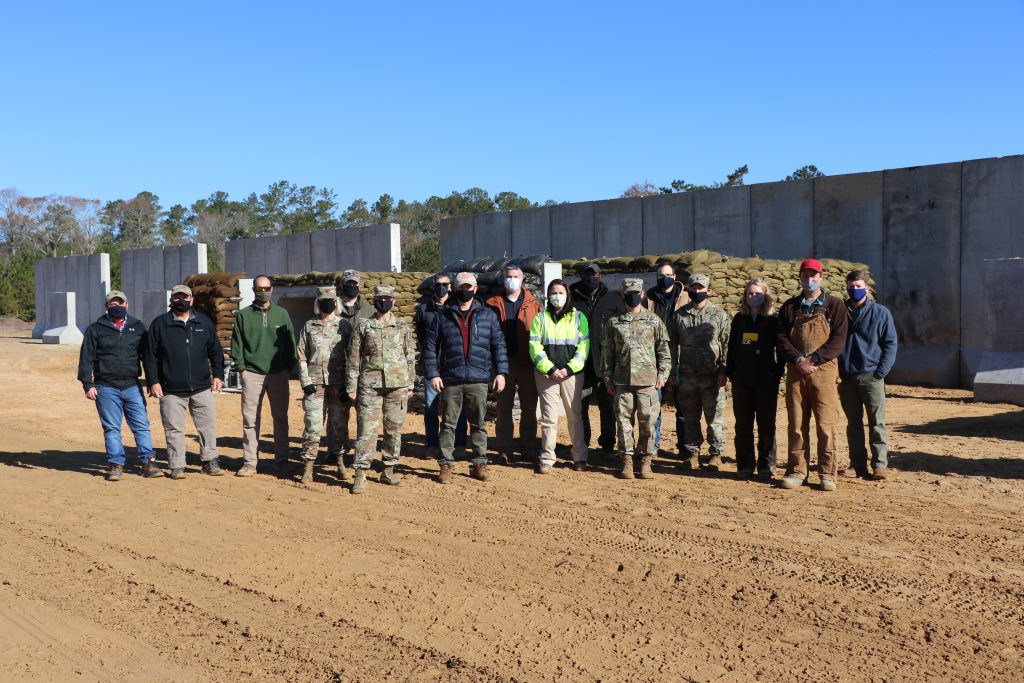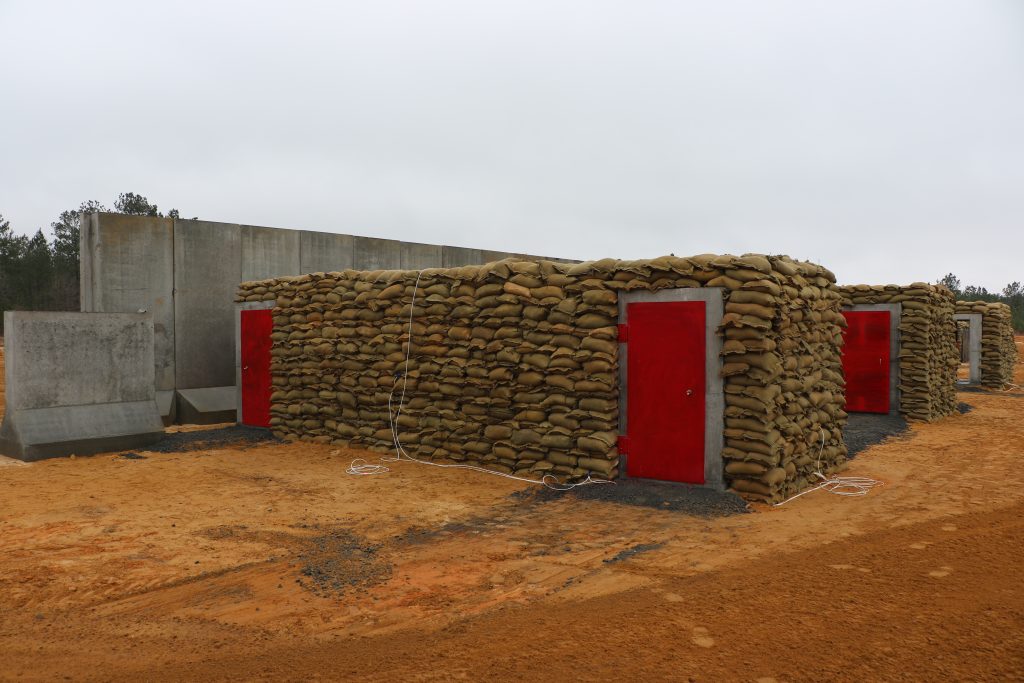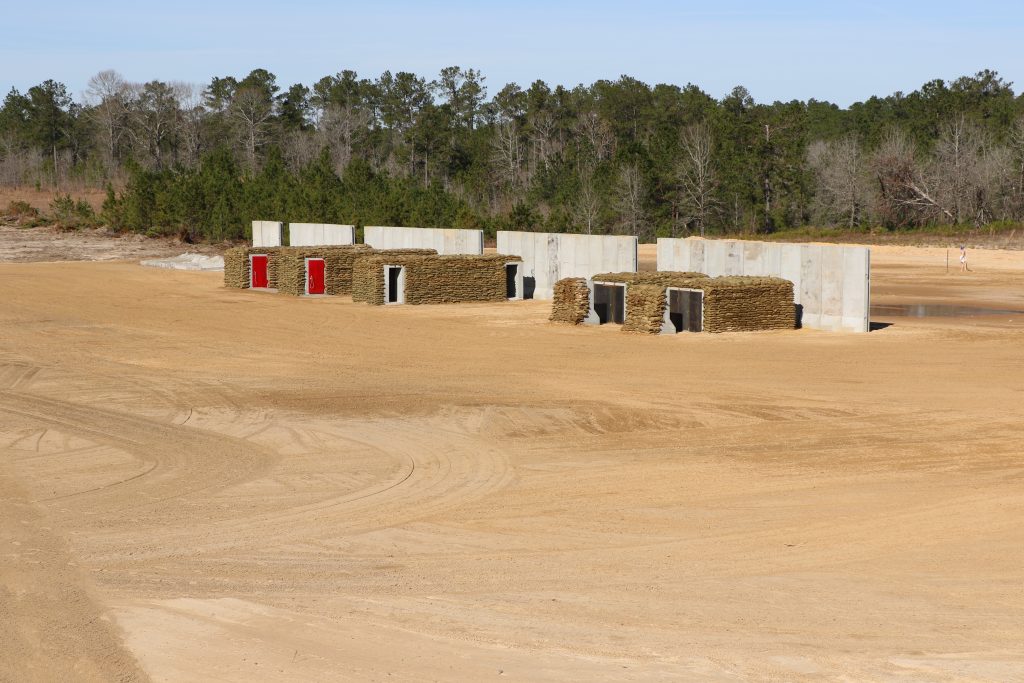
OBSERVATIONS AND EXPERIMENTATION: Maj. Gen. Kimberly Colloton and Col. (Ret.) Teresa Schlosser visit an experiment to test the new bunker retrofit at Ft. Polk, Louisiana, in December 2020.
New bunker designs will protect against brain injuries.
by Tim Reeves and Chris Kieffer
In the early hours of Jan. 8, 2020, American troops and civilians stationed at the Al Asad Air Base in Iraq put the finishing touches on their preparations for an impending attack from Iranian forces.
Thanks to advance information and intelligence, commanders on the ground were given time to move many of the troops and each of the base’s 51 aircraft to safety.
Those who remained donned body armor and helmets and staged inside the base’s open-ended bunkers. While they knew of the impending attack, they did not know the extent of what they were facing.
With Iranian missiles enroute, the estimated 2,000 remaining troops sought protection in the bunkers designed to protect them against rockets and mortars. But, during the ensuing 80-minute bombardment, the threat was far more and far larger than expected.
Throughout the barrage, the base was battered by more than a dozen ballistic missiles, carrying warheads in excess of 1,000 pounds.
As the echo of the final strike subsided, leaders took stock of the damage and injuries. Early reports found that although the damage was significant, no one was killed. However, in the weeks and months that followed, more than 100 service members and civilian contractors at the base were diagnosed with traumatic brain injuries (TBI).
Those injuries were tied back to the blast waves generated during the attack and how those waves echoed and were further amplified throughout the bunkers.

DROP-INS WELCOME: Less than a year after the attack at Al Asad Air Base, Maj. Gen. Kimberly Colloton, then commanding general of the USACE Transatlantic Division (TAD), visited with the U.S. Army Engineer Research and Develop Center and TAD scientists and engineers at the range at Fort Polk, Louisiana, where the new bunker retrofit was being tested in December 2020.
BRAIN WORK
In response to this attack and the resulting injuries, engineers and scientists at the U.S. Army Engineer Research and Development Center (ERDC), in coordination with the U.S. Army Corps of Engineers (USACE) Transatlantic Division and the USACE Protective Design Center (PDC), developed simple and effective bunker enclosure door designs for the U.S. Central Command (CENTCOM). The new designs sought to reduce the peak pressures experienced by an individual seeking shelter in a bunker by more than 90 percent.
The response was rapid. The USACE Reachback Operations Center received a request on the day of the attack seeking ERDC’s expertise in developing a protective solution. ERDC immediately assembled a team of experts to support rapid deployment of an in-theater modular protective system and to provide tele-engineering support to CENTCOM for immediate courses of action. The team also began working on a quick-reaction research plan to address the traumatic brain injury issue.
“This project had high visibility and a short timeline,” said Jessica K. Fulk, a research civil engineer at ERDC’s Geotechnical and Structures Laboratory and project lead for the bunker effort.
By August of 2020, CENTCOM tasked ERDC to replicate the events from January 2020 to measure the blast properties that were experienced by the Soldiers and to reduce blast pressures inside the bunkers.
The research team completed 120 high-fidelity simulations using ERDC’s DOD high performance computing system to evaluate pressure flow in and around objects. The research used three million processor hours on DOD High Performance Computing Modernization Program (HPCMP) systems, as the complex models each took 10 to 24 hours per run on these supercomputers.
This modeling investigated a matrix of conditions, such as occupant location and bunker orientation and geometry. But the findings showed that changing these parameters did not significantly reduce personnel exposures.
In their testing, researchers found that using doors to enclose the bunkers was the most expedient and effective means to manipulate the internal blast conditions, reducing the likelihood for traumatic brain injury. The door design reduces internal bunker peak pressure by nearly seven times compared to open air.
The team worked closely with the Missile and Space Intelligence Center and the National Ground Intelligence Center to collect information and guide the design of the enclosure. They coordinated with the Medical Research and Development Command to gain a better understanding of traumatic brain injuries.

TRIED AND TRUE: The experiments validated several ERDC-developed bunker modifications that reduced the exposure to personnel within the bunker and reduced their vulnerability to traumatic brain injuries.
BRAINS ARE DYNAMIC AND FLUID
“Around the time our project was wrapping up a news article came out discussing the lasting effects of traumatic brain injury that the Soldiers from Al Asad have experienced, which drove home the importance of what our team was accomplishing,” Fulk said.
“Our main goal is always to protect the warfighter,” she continued, “and this is a unique instance where we were able to see widespread fielding of our solutions that will help prevent these injuries and save lives in the event of future attacks.”
In December 2020, less than a year after the attack, leveraging years of survivability research conducted under ERDC’s Expedient Passive Protection program, large-scale field experiments were held on the enclosures, which validated the research and computational models.
The final set of large-scale experiments were executed in January 2021. These tests validated several ERDC-developed bunker modifications that reduced the exposure to personnel within the bunker and reduced the vulnerability to traumatic brain injuries. These modifications took into consideration ease of implementation, cost and the ability to construct.
SCALABLE FUTURE
The final design package was completed in July 2021, with nearly 1,000 bunkers spread throughout other countries identified for retrofit.
“The larger team’s constant flow of data forced our prototype at ERDC to focus on the future scalability,” said John M. Hoemann, a research civil engineer at ERDC’s Geotechnical and Structures Laboratory. “Our design loads for future retrofits varied based on streaming threat data from the theater. Listening to the real-time needs that might change during a daily call required us to hear, compile and adapt the designs.
“Ultimately, we wrapped up not just a prototype, but a process for redesigning for different scenarios. We had to do this to truly make an adaptable prototype,” he said.
ERDC’s bunker retrofit solution was developed, tested and deployed in less than a year – thanks in large part to ERDC’s core competency in blast and weapons effects on structures. It also benefitted from the research organization’s cross-laboratory environment. For example, ERDC used its 3D printing capabilities to quickly produce unique instrumentation mounts that simulated a human head for field testing. Meanwhile, ERDC’s work in invasive species and fish migration allowed the team to pull in a biologist with enough knowledge of brain injuries to better interface with the experts at the Medical Research and Development Command.
CENTCOM Commander Gen. Kenneth F. McKenzie Jr. recognized this effort, by thanking the ERDC team for its “extraordinary work on the Personnel Bunker Study.”
“The recent attack on U.S. personnel at Al Asad Air Base served as a reminder of the very real dangers our military members face carrying out their daily missions,” McKenzie wrote. “I am confident that your study findings will reduce the risks posed to our military and will ultimately save lives. ERDC and the Army Corps of Engineers continue to be valuable members of the USCENTCOM team and combat multipliers across my area of responsibility.”
The team that completed the Personnel Bunker Study was also recognized with a 2022 Innovation of the Year award from the U.S. Army Corps of Engineers.

BUNKERS GET A BOOST: The U.S. Army Engineer Research and Development Center, along with collaborators, developed bunker modifications that reduced the exposure to personnel within the bunkers and reduced their vulnerability to traumatic brain injuries. A modified concrete bunker undergoes testing at a range at Fort Polk, Louisiana, in January 2021. (Photos provided by U.S. Army Engineer Research and Development Center)
CONCLUSION
Because the USACE Transatlantic Division supports engineering activities across the joint forces in CENTCOM’s area of responsibility, this solution was applied broadly.
The U.S. Air Force has begun implementation of these specific designs and configurations for their applications as well.
ERDC and the USACE Transatlantic Division have briefed leaders within the U.S. Africa and U.S. Indo-Pacific Commands on this research and have received interest on implementing its recommendations.
Additionally, the knowledge gained regarding protection from traumatic brain injury has driven additional efforts from the USACE Protective Design Center and assisted in the understanding and development of new training and safety concerns being addressed by the U.S. Army Counter Explosive Hazards Center.
The blast data also will be provided to the medical community for future traumatic brain injury research.
“This project was very different from others I have worked on in that it was a very specific but very challenging problem where we had to find a deployable solution with very limited time,” said Dr. Catie Stephens, a research civil engineer at ERDC’s Geotechnical and Structures Laboratory. “This project could have required hundreds of experiments to better understand the problem, but we were able to do a very small set of large experiments that allowed us to solve the main request, a retrofit to bunkers that decreases the risk of traumatic brain injury, while also gathering data that is valuable for solving the problem—how and why blast induced traumatic brain injuries occur. All of that data was shared with the Medical Research and Development Command in order for them to make progress on the bigger problem.”
For more information, email ERDCInfo@usace.army.mil, or go to https://www.erdc.usace.army.mil/Locations/GSL.aspx.
TIM REEVES is a communications specialist with the U.S. Army Engineer Research and Development Center. Prior to joining ERDC’s Corporate Communications team, Reeves spent nearly three decades in journalism working as photographer, reporter and editor at newspapers throughout the Southeast United States.
CHRIS KIEFFER is a communications specialist with the U.S. Army Engineer Research and Development Center. He spent more than a decade as a reporter and editor with the Northeast Mississippi Daily Journal and Oxford (Mississippi) Eagle newspapers. Kieffer holds an M.A.in journalism from Columbia University and a B.A. in journalism from the University of Mississippi.







